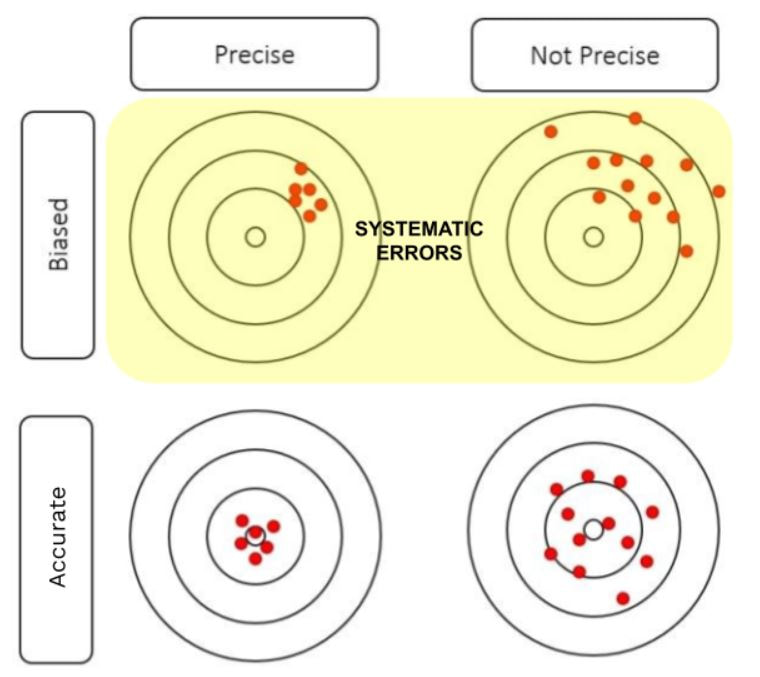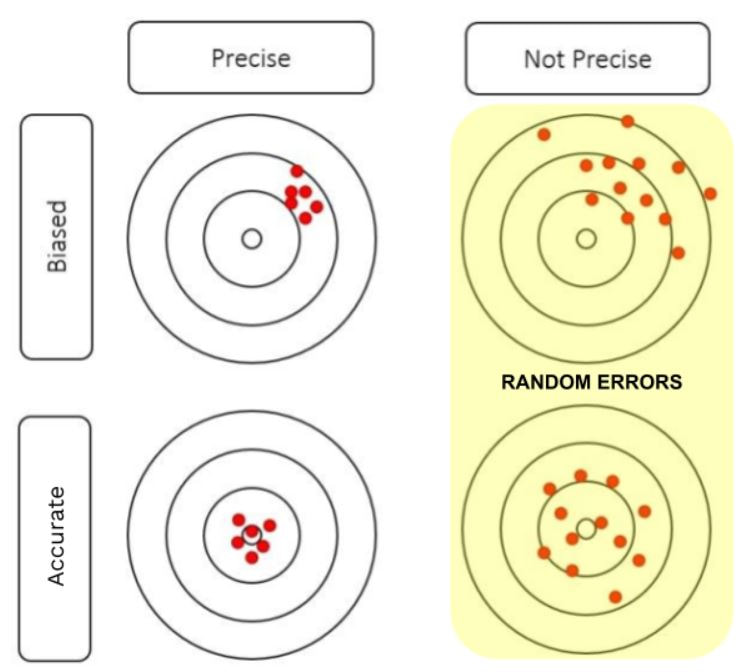Error Analysis
All scientific investigations have errors to some degree. An error is the difference between a measurement and the true value being measured. Please note, errors are not mistakes due to experimenter carelessness, sloppiness or being rushed.
An appreciation of error should be apparent at all stages of an investigation.
In general, errors can be classified as either systematic or random.
An appreciation of error should be apparent at all stages of an investigation.
- In the planning stages, the limitations of the time and the materials should be assessed, and the potential sources of error should be controlled.
- In the data collection and processing stages, the degree of accuracy of a measuring device should be stated.
- In the evaluation of the investigation, the sources of error should be discussed, along with the possible ways of avoiding them.
In general, errors can be classified as either systematic or random.
Systematic Errors: faults or flaws in the investigation design or procedure that shift all measurements in a systematic way so that in the course of repeated measurements the measurement value is constantly displaced in the same way. Systematic errors can be eliminated with careful experimental design and techniques.
Systematic errors impact ACCURACY of a measurement. Accuracy is the “closeness of the measurements to a true value.” Measurements with a low level of systematic error have a high accuracy. Measurements with a high level of systematic error are “biased.”
Systematic errors impact ACCURACY of a measurement. Accuracy is the “closeness of the measurements to a true value.” Measurements with a low level of systematic error have a high accuracy. Measurements with a high level of systematic error are “biased.”
- Error in measurement instrument use and calibration: for example, if an electronic scale reads 0.05 g too high for all mass measurements because it was improperly tared.
- Faulty measurement equipment: for example, if a tape measure has been stretched out so everything you measured with it is larger than reality.
- Faulty use of measurement equipment: for example, if a researcher consistently reads a graduated cylinder from above (as opposed to directly looking at the meniscus).
- Sensitivity limits: because of its measurement uncertainty, an instrument may not be able to respond or indicate a change in a quantity that is too small. So, only larger measurements are recorded, biasing results towards larger measures.
Random Errors: errors caused by unknown and unpredictable changes in a measurement, either due to measuring instruments or environmental conditions. You can't eliminate random errors. You can reduce the effect of random errors by taking multiple measurements and increasing sample sizes.
Random errors impact PRECISION of a measurement. Precision is the “closeness of repeated measurements of the same thing.” Precise measurements will have low spread relative to their measure of central tendency. Measurements with a low level of random error have a high precision. Measurements with a high level of random error have low precision.
Random errors impact PRECISION of a measurement. Precision is the “closeness of repeated measurements of the same thing.” Precise measurements will have low spread relative to their measure of central tendency. Measurements with a low level of random error have a high precision. Measurements with a high level of random error have low precision.
- Variation in measurement readings: for example, if one person reads 27.5 degrees and another person reads 27.8 degrees when taking the temperature of the same solution. This error can be minimized by taking more data and averaging over a large number of observations.
- Sample size: a small sample size is going to increase the uncertainty of the conclusions being drawn. A small sample size is going to increase the impact of any single error in measurement. By having a large sample, the impact of any one random error is diluted.
- Background noise: noise is extraneous disturbances that are unpredictable or random and cannot be completely accounted for. For example, when taking an ECG measurement, the presence of a cell phone near the monitoring device might effect the measurements.
- Intrinsic variability: biological material is notably variable from subject to subject or within the same subject over the course of time. For example, the solute concentration of potato tissue may be calculated by soaking pieces of tissue in a range of concentrations of sucrose solutions. However, different pieces of tissue will vary in their osmolarity especially if they have been taken from different potatoes.
- Sensitivity limits: an instrument may not be able to respond or indicate a change in a quantity that is too small or the observer may not notice the change. For example, the resolution limitations of a microscope may limit an observer from noticing changes in a cell structure.
- The act of measuring: when a measurement is taken this can affect the environment of the experiment. For example when a cold thermometer is put in a test tube of warm water, the water will be cooled by the presence of the thermometer. Or, an animal being observed changes it's behavior because of the presence of the researcher in its habitat.
- Measurement uncertainty: every measuring device has a range in which the measurements are accurate. A researcher may randomly sample on the higher end or lower end of the measurement range, which would decrease precision.
- Experimenter fatigue: when people have to make a large number of tedious measurements, their concentration spans vary. Automated measuring, for example through the use of a data logger system, can help reduce the likelihood of this type of error. Alternatively, the experimenter can take a break occasionally.
- Experimenter experience: novice researchers are more likely to make random errors because they may not have training or experience in observing or measuring.
Once you have identified the sources of error, you must explain how they affected your results. Did they make your experimental values increase or decrease. Why?
For additional information, see this link.
For additional information, see this link.

